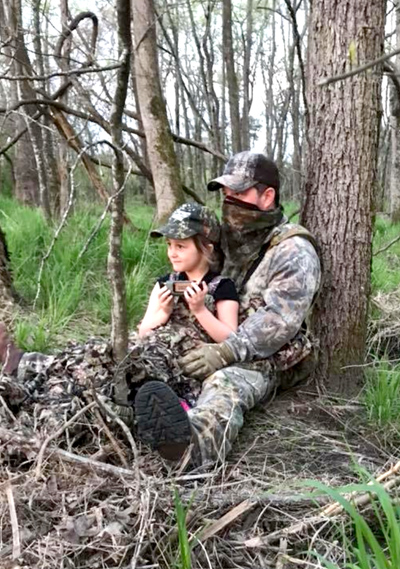 FIVE-YEAR OLD RILEY TURNER ACCOMPANIED HER PARENTS, Josh and Amy, on a weekend turkey hunt and is learning to call turkeys. She insists on wearing dresses, so her grandmother made her a camouflage dress to hunt in. Riley, like all young hunters, is also learning the importance of sitting still while turkey hunting. (Photo by Amy Turner)
FIVE-YEAR OLD RILEY TURNER ACCOMPANIED HER PARENTS, Josh and Amy, on a weekend turkey hunt and is learning to call turkeys. She insists on wearing dresses, so her grandmother made her a camouflage dress to hunt in. Riley, like all young hunters, is also learning the importance of sitting still while turkey hunting. (Photo by Amy Turner)
Spring turkey season is open and in high gear throughout most of Texas’ range. If you hunt in East Texas, however, you’d better check the TPWD Outdoor Annual (the hunting and fishing regulations pamphlet). Quite a few East Texas counties are closed to spring turkey hunting to allow recent stocking of eastern turkeys to take hold and multiply.
Whether that ever happens is dubious, since numerous turkeys have been stocked there, yet populations are still low.
But Rio Grande turkey populations in many other counties remain high and healthy. At one time, Texas claimed to be home to one-fourth of all turkeys in America. The Carolinas and Florida have healthy populations, as do other states, but Texas still ranks high among turkey hunting states.
The South Zone for Rio Grande turkey hunting opened Mar. 17 and closes Apr. 29. The North Zone opened Mar. 31, closes May 13. In counties only allowing one turkey gobbler, the season runs Apr. 1- 30. Most other counties in the South and North zones allow a four-bird bag limit (fall and spring seasons combined).
Unlike the opening day of deer hunting, spring turkey hunting is often better later in the season. And, why so?
Well, spring turkey season, like fall deer season, is set to coincide with the mating season. But unlike fall deer season, you don’t have to be in the woods on opening day to drop a gobbler … unless you want to.
All too often, gobblers in early season have so many possible girlfriends that they don’t get interested in hearing one of the camo-clad nation of hunters trying to mimic a willing hen letting gobblers know she’s looking for a date. Uh, make that “looking for a mate.”
Leading a photo workshop on the Y.O. Ranch one spring, I had the photographers well concealed in the brush right at daylight. I heard a gobbler close by and off to our left. I struck my box call a few strokes, hoping to sound like a turkey hen. The gobbler answered. I called again. Same response. This dialogue continued for five or six minutes. Each sequence brought the gobbler closer.
Then it seemed to be moving on past us to the right. I called intermittently, but to no avail. He had quit responding.
I wondered if it was something I said. I waited, hoping. When the silence convinced me the gobbler had left the area, I walked to where his gobbles had seemed closest to us. Off to the right, about 400 yards away, I could see a pair of turkeys plodding along near the crest of a hill. Binoculars identified them as a tom and a hen. The occupied couple had no interest in a ménage a trois.
A multitude of unbred hens in early season can cause that. Later, gobblers are more likely to come to calls since many hens are already bred, and out of circulation.
So, get out there – and give ‘em a call.
JJ





